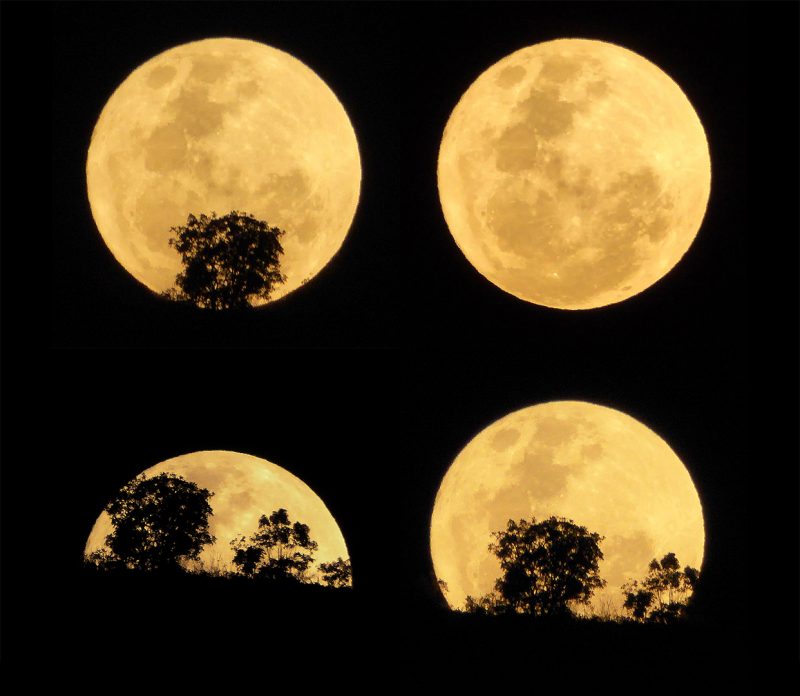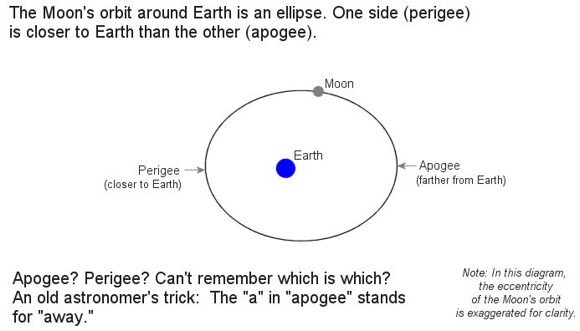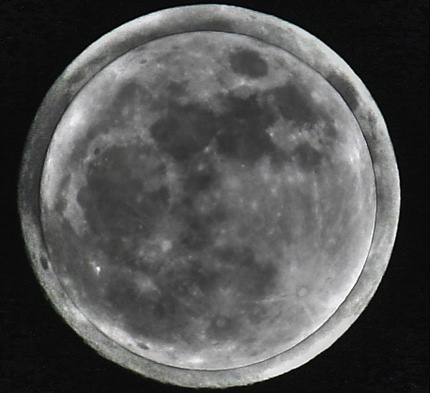
The full moon on February 9, 2020, ranks as the fourth-closest (and therefore the fourth-largest and fourth-brightest) of the 13 full moons occurring in the year 2020, but commentators disagree on whether it should be dubbed a supermoon.
The word supermoon has arisen in popular culture, and there’s no official definition for one. The International Astronomical Union (IAU) is the group generally recognized for naming and defining things in astronomy. But the IAU has been, so far, silent on the subject of supermoons, which professional astronomers might prefer to call perigean full moons.
Here are three different sources of supermoon info in 2020.
First, the excellent website TimeandDate.com says:
There are no official rules as to how close or far the moon must be to qualify as a supermoon or a micro moon. Different outlets use different definitions. Due to this, a full moon classified as a supermoon by one source may not qualify as a super full moon by another.
TimeandDate goes on to give its own definition of a supermoon:
A full or new moon that occurs when the center of the moon is less than 360,000 kilometers (ca. 223,694 miles) from the center of Earth.
By TimeandDate’s defintion, only the full moons of March and April count as full supermoons in 2020.
Our second source is Fred Espenak, the go-to astronomer on all things related to lunar and solar eclipses. He lists the full moon of February 9, 2020, as a supermoon in his post Full Moon at Perigee. You’ll also find a table in that post, showing his list of supermoons for the 21st century. Fred Espenak lists four full moon supermoons for 2020:
2020 February 9
2020 March 9
2020 April 8
2020 May 7
Click here to learn more about Fred Espenak
Now here’s a third source: the astrologer Richard Nolle. Whatever your thoughts or feelings about astrology, Nolle is, after all, the person who coined the term supermoon. He dosen’t include the full moon of February 9, 2020, on his supermoon list for the 21st century. Richard Nolle’s list agrees with TimeandDate.com that there are only two full moon supermoons for 2020:
2020 March 9
2020 April 8
Click here to learn more about Richard Nolle
Why are the various lists different? It all goes back to the definition of the word supermoon.
Here’s one thing we all can agree on. Supermoons are based on lunar perigee and apogee. Each month, the moon comes closest to Earth at perigee and swings farthest away at apogee.

In his original definition, Richard Nolle defined a supermoon as:
… a new or full moon which occurs with the moon at or near (within 90% of) its closest approach to Earth in a given orbit.
If a new or full moon aligns with apogee, then it’s at 0% of its closest approach to Earth. On the other hand, if a new or full moon aligns with perigee, then it’s at 100% of its closest approach to Earth. That’s something we can all agree on.
But the phrase 90% of perigee is ambiguous. Read on.

Nolle’s 90% is based on 2020’s closest perigee and farthest apogee. Looking at Richard Nolle’s list for all the supermoons in the 21st century, it appears that Richard Nolle might base his 90% figure on the year’s closest perigee and farthest apogee. Let’s take the year 2020. Based on the year’s closest perigee and farthest apogee, any new or full moon coming closer than 224,865 miles (361,885 miles) qualifies as a supermoon.
Here are the distances of the four closest full moons in 2020:
Full moon (February 9, 2020): 225,234 miles or 362,479 km
Full moon (March 9, 2020): 222,081 miles or 357,404 km
Full moon (April 8, 2020): 221,851 miles or 357,035 km
Full moon (May 7, 2020): 224,429 miles or 361,184 km
This year, in 2020, the moon swings farthest away from Earth on March 24 (252,707 miles or 406,692 km), and then sweeps closest to Earth one fortnight (two weeks) later, on April 7 (221,772 miles or 356,907 km). That’s a difference of 30,935 miles or 49,785 km. Ninety percent of the difference = 27,842 miles or 44,807 km. Presumably, any new or full moon coming closer than 224,865 miles (361,885 km) would be “at or near (within 90% of) its closest approach to Earth.”
Farthest apogee (2020): 252,707 miles (406,692 km)
Closest perigee (2020): 221,772 miles (356,907 km)
Difference (2020): 30,935 miles (49,785 km)
90% x 30,935 miles (49,785 km) = 27,842 miles (44,807 km)
90% of moon’s closest distance to Earth = 252,707 miles (406,692 km) – 27,942 miles (44,807 km) = 224,865 miles (361,885 km)
Thus, figuring out “90% of the moon’s closest approach to Earth” by the year’s closest perigee and farthest apogee, any new or full moon coming closer than 224,865 miles (361,885 km) to Earth, as measured from the centers of the Earth and moon, counts as a supermoon in 2020.
Since the full moon on February 9, 2020, only comes within 225,234 miles (362,479 km) of Earth, it doesn’t count as a supermoon on Richard Nolle’s list. But we’re not quite sure why the full moon of May 7, 2020, didn’t make Nolle’s list.

Espenak’s 90% based on perigee and apogee of each month’s orbit. Ironically, Fred Espenak’s full supermoon list might more strictly adhere to Richard Nolle’s definition (at least as it is written) than Richard Nolle himself does.
Once again, Richard Nolle describes a supermoon as:
… a new or full moon which occurs with the moon at or near (within 90% of) its closest approach to Earth in a given orbit.
If given orbit can be taken to mean current monthly orbit, then the February full moon comes to within 95.5% of its closest approach to Earth relative to the most recent apogee and the upcoming perigee.
January 29, 2020 apogee: 251,900 miles (405,393 km)
February 10, 2020 perigee: 223,980 miles (360,461 km)
Difference: 27,920 miles (44,932 km)
January 29, 2020 apogee: 251,900 miles (405,393 km)
February 9, 2020 full moon: 225,234 miles (362,479 km)
Difference: 26,666 miles (42,914 km)
26,666/27,920 = 0.955 (99.5%) = distance of the February 2020 full moon relative to the most recent apogee and upcoming perigee.
Depending on what meaning we give to the words in a given orbit, we could say the January 29 apogee = 0% of the moon’s closest approach to Earth for this orbit, and the February 10 perigee = 100% of the moon’s closest approach to Earth.
That being the case, then the February full moon comes to within 95.5% of its closest approach to Earth for the month.

February full moon’s distance relative to 2020’s closest perigee/farthest apogee. However, if we compute the percentage distance of the February full moon relative to the year’s farthest apogee and closest perigee, then the February full moon only comes to within 88.8% of its closest approach to Earth:
Farthest apogee (2020): 252,707 miles (406,692 km)
Closest perigee (2020): 221,772 miles (356,565 km)
Difference: 30,935 miles (49,785 km)
Farthest apogee (2020): 252,707 miles (406,692 km)
February full moon (2020): 225,234 miles (362,479 km)
Difference (2020): 27,473 miles (44,213 km)
27,473/30,935 = 0.888 (88.8%) = distance of the February full moon relative to the year’s farthest apogee and closest perigee.

Is the February full moon a supermoon? Depends on which perigee/apogee distances you choose. The moon’s perigee and apogee distances vary throughout the year, so it appears that the limiting distance for the supermoon depends on which perigee and apogee distances are being used to compute 90% of the moon’s closest approach to Earth.
If we choose the year’s closest perigee and farthest apogee, as Nolle did, we narrow the definition of supermoon.
If we choose the perigee and apogee for a given monthly orbit, as Espenak did, then we broaden the definition of supermoon.
Given the narrower definition, the full moon on February 9, 2020, is not a supermoon, but given the broader one, it is.
Take your choice!

Read more: How many supermoons in 2020?
Bottom line: We list three sources for whether the February 9, 2020, full moon should be called a supermoon: the website TimeandDate.com, astronomer Fred Espenak, and astrologer Richard Nolle. If you define a supermoon based on the year’s closest perigee and farthest apogee, then the February 2020 full moon is not a supermoon. If you define a supermoon based on the perigee and apogee for a given monthly orbit, then it is a supermoon. Take your choice!











